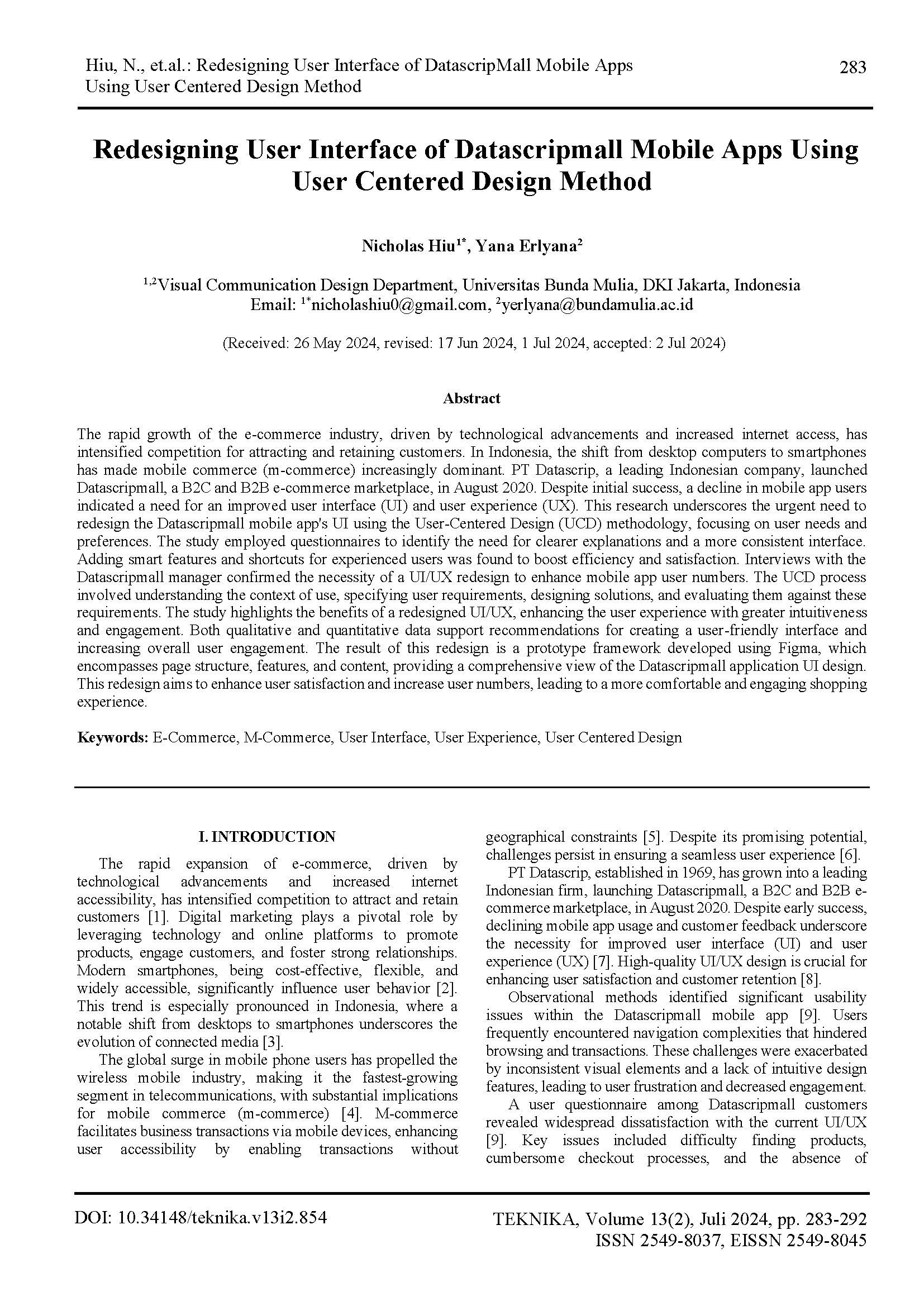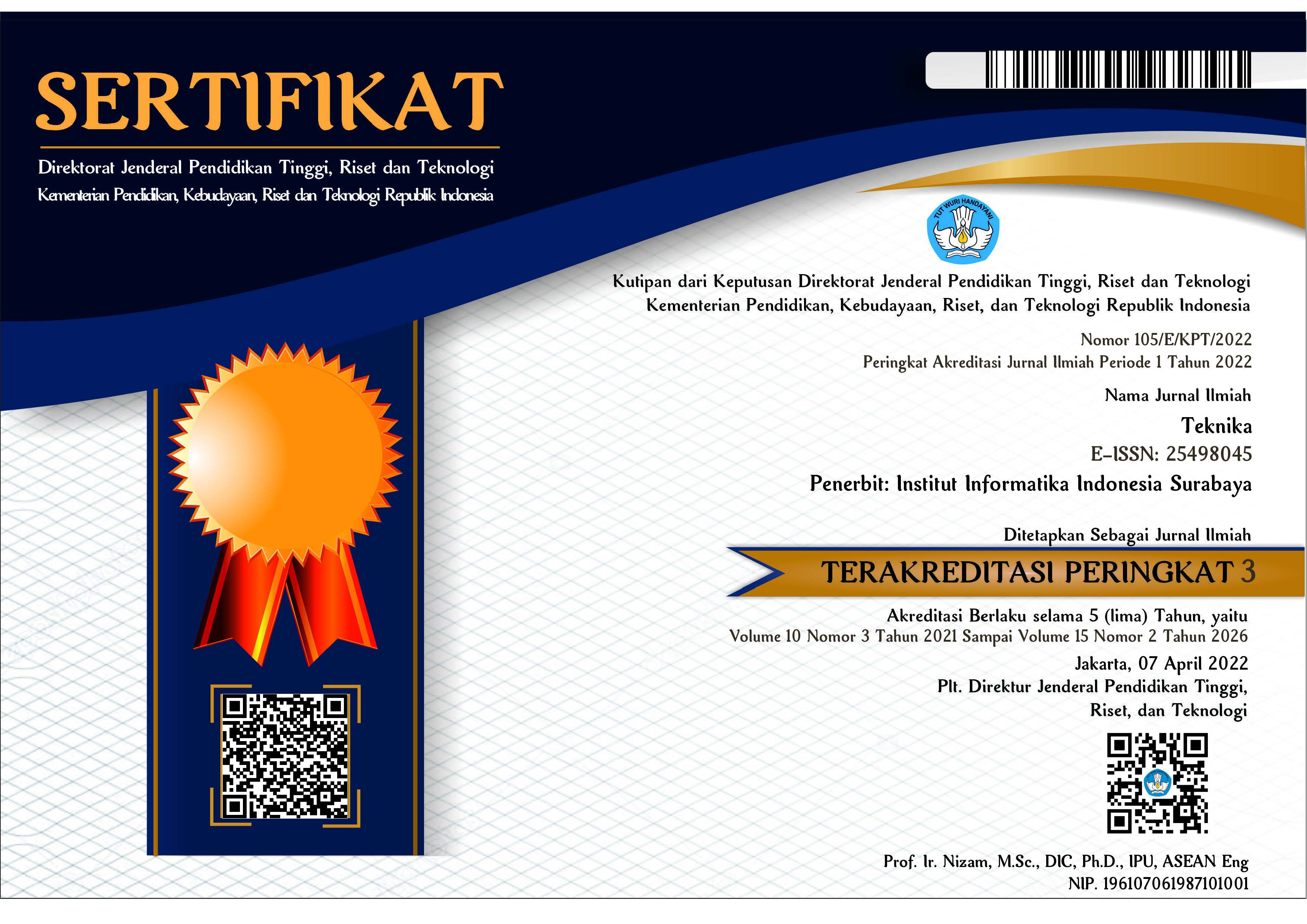Redesigning User Interface of Datascripmall Mobile Apps Using User Centered Design Method
DOI:
https://doi.org/10.34148/teknika.v13i2.854Keywords:
E-Commerce, M-Commerce, User Interface, User Experience, User Centered DesignAbstract
The rapid growth of the e-commerce industry, driven by technological advancements and increased internet access, has intensified competition for attracting and retaining customers. In Indonesia, the shift from desktop computers to smartphones has made mobile commerce (m-commerce) increasingly dominant. PT Datascrip, a leading Indonesian company, launched Datascripmall, a B2C and B2B e-commerce marketplace, in August 2020. Despite initial success, a decline in mobile app users indicated a need for an improved user interface (UI) and user experience (UX). This research underscores the urgent need to redesign the Datascripmall mobile app's UI using the User-Centered Design (UCD) methodology, focusing on user needs and preferences. The study employed questionnaires to identify the need for clearer explanations and a more consistent interface. Adding smart features and shortcuts for experienced users was found to boost efficiency and satisfaction. Interviews with the Datascripmall manager confirmed the necessity of a UI/UX redesign to enhance mobile app user numbers. The UCD process involved understanding the context of use, specifying user requirements, designing solutions, and evaluating them against these requirements. The study highlights the benefits of a redesigned UI/UX, enhancing the user experience with greater intuitiveness and engagement. Both qualitative and quantitative data support recommendations for creating a user-friendly interface and increasing overall user engagement. The result of this redesign is a prototype framework developed using Figma, which encompasses page structure, features, and content, providing a comprehensive view of the Datascripmall application UI design. This redesign aims to enhance user satisfaction and increase user numbers, leading to a more comfortable and engaging shopping experience.
Downloads
References
D. Sholihah, “Pengaruh Islamic Marketing Mix Terhadap Loyalitas Pelanggan Dalam Pembelian Baju Muslim Melalui Situs Belanja Online (E-Commerce) Perspektif Ekonomi Islam (Pengguna Shopee Masyarakat Kabupaten Jember),” Pengguna Shopee Masyarakat Kabupaten Jember)(Doctoral dissertation, Universitas Islam Negeri Kiai Haji Achmad Siddiq Jember), 2021.
N. Abdallah et al., “Determinants of M-commerce adoption: an empirical study,” J Theor Appl Inf Technol, vol. 98, no. 9, pp. 1480–1488, 2020.
A. R. Pradana and M. Idris, “Implementasi user experience pada perancangan user interface mobile e-learning dengan pendekatan design thinking,” AUTOMATA, vol. 2, no. 2, 2021.
A. W. Siyal, H. Chen, S. J. Shah, F. Shahzad, and S. Bano, “Customization at a glance: Investigating consumer experiences in mobile commerce applications,” Journal of Retailing and Consumer Services, vol. 76, p. 103602, 2024.
H. AlFahl, “Mobile commerce adoption,” in Network Security and Its Impact on Business Strategy, IGI Global, 2019, pp. 170–184.
M. S. Nodirovna and A. S. Sharif oʻg‘li, “E-Commerce Trends: Shaping The Future of Retail,” Open Herald: Periodical of Methodical Research, vol. 2, no. 3, pp. 46–49, 2024.
I. A. Adha, A. Voutama, and A. A. Ridha, “Perancangan UI/UX Aplikasi Ogan Lopian DISKOMINFO Purwakarta Menggunakan Metode Design Thinking,” JOISIE (Journal Of Information Systems And Informatics Engineering), vol. 7, no. 1, pp. 55–70, 2023.
R. B. Solichuddin, “Perancangan User Interface Dan User Experience Dengan Metode User Centered Design Pada Situs Web" Kalografi",” 2021.
Sugiyono, Metode penelitian kuantitatif, kualitatif, dan R&D, vol. 3. Bandung: Alfabeta, 2021.
S. P. M. S. Dr. R. A. Fadhallah, Wawancara. UNJ Press, 2021. [Online]. Available: https://books.google.co.id/books?id=rN4fEAAAQBAJ
A. A. Puji and V. Engraini, “Perancangan User Interface Website E-Commerce Pada Usaha Kuliner Menggunakan User Centered Design,” Jurnal CoSciTech (Computer Science and Information Technology), vol. 2, no. 1, pp. 1–8, 2021.
H. Himawan and M. Yanu F, “Interface User Experience.” Lembaga Penelitian dan Pengabdian kepada Masyarakat UPN Veteran Yogyakarta, 2020.
A. K. Nisah and H. Ajie, “Perancangan berbasis User Experience pada Modul Admin Sistem Informasi Akademik Universitas Negeri Jakarta,” PINTER: Jurnal Pendidikan Teknik Informatika dan Komputer, vol. 5, no. 2, pp. 56–64, 2021.
D. L. Kaligis and R. R. Fatri, “Pengembangan Tampilan Antarmuka Aplikasi Survei Berbasis Web Dengan Metode User Centered Design,” JUST IT: Jurnal Sistem Informasi, Teknologi Informasi dan Komputer, vol. 10, no. 2, pp. 106–114, 2020.
B. Harijanto, I. K. Putri, and H. N. Javier, “Penerapan Metode User Centered Design (UCD) Katalog Online Berbasis Web di Rumah Makan Alfa Lesehan Kabupaten Blitar,” in Seminar Informatika Aplikatif Polinema, 2021, pp. 147–156.
P. Z. Dinata, M. A. Urwah, M. R. Rahmawan, and E. Junaeti, “Perancangan UI/UX Web e-Commerce ‘Hallo Coffee’Menggunakan Metode User Centered Design,” Jambura Journal of Informatics, vol. 5, no. 1, pp. 45–58, 2023.
M. A. Dzaky and I. A. Musdar, “Analisis Dan Perancangan UI/UX Pada Startup Renovaction Menggunakan Metode User Centered Design,” KHARISMA Tech, vol. 17, no. 1, pp. 16–30, 2022.
D. A. Fatah, R. M. Yusron, I. D. Febrianti, and O. M. A. Husnah, “Penerapan Metode User-Center Design (Ucd) Untuk E-Commerce Industri Kreatif,” Jurnal Simantec, vol. 10, no. 1, pp. 31–40, 2021.
A. A. Yunanto, F. F. Putri, D. I. Permatasari, F. F. Hardiansyah, U. Sa’adah, and A. S. Aziz, “Design and Implementation the Prayer Reminder Application using KISS Principle based on User Centered Design,” Procedia Comput Sci, vol. 234, pp. 1484–1491, 2024.
E. K. Wati, H. H. Santoso, and A. Laksono, “IOT-Based Water Level Monitoring System of Situ Rawa Besar,” MSJ: Majority Science Journal, vol. 2, no. 1, pp. 219–231, 2024.
H. W. Alomari, V. Ramasamy, J. D. Kiper, and G. Potvin, “A User Interface (UI) and User eXperience (UX) evaluation framework for cyberlearning environments in computer science and software engineering education,” Heliyon, vol. 6, no. 5, 2020.
S. M. Muhtar, A. S. Amir, and N. Amir, “Utilizing Social Media For Public Health Advocacy And Awareness In Digital Health Communication. Majority Science Journal (MSJ). Vol. 2No. 1, February 2024.”
I. K. Sukarma, “Ethnoscience Analysis In Science Learning in Primary Schools (Elementary School),” MSJ: Majority Science Journal, vol. 1, no. 4, pp. 164–171, 2023.
M. Iqbal, G. I. Marthasari, and I. Nuryasin, “Penerapan Metode UCD (User Centered Design) pada Perancangan Aplikasi Darurat Berbasis Android,” Jurnal Repositor, vol. 2, no. 2, 2020.
C. Lim, A. C. Sumarlie, F. Fernando, and D. A. Haris, “Perancangan Ui/Ux Aplikasi Absensi ‘Jikan’ Dengan Metode User Centered Design. Computatio: Journal of Computer Science and Information Systems, 5 (1), 16.” 2021.
A. D. Adam and E. Trisna, “Pengaruh Servicescape, Kualitas Komunikasi Pelayanan Dan Kepercayaan Nasabah Terhadap Kepuasan Dan Dampaknya Pada Relationship Intention Nasabah Bank Syariah Di Surabaya,” Develop, vol. 3, no. 1, p. 43, 2019.
Aorinka Anendya, “Pengertian Usability Testing: Metode dan Manfaatnya bagi Bisnis,” Dewaweb. Accessed: Mar. 17, 2024. [Online]. Available: https://www.dewaweb.com/blog/pengertian-usability-testing/
T. K. Situmorang, H. M. Az-Zahra, and A. D. Herlambang, “Evaluasi Usability Pada Aplikasi m-KantorPos dengan Menggunakan Metode Usability Testing,” Jurnal Pengembangan Teknologi Informasi dan Ilmu Komputer, vol. 3, no. 5, pp. 4349–4356, 2019.























